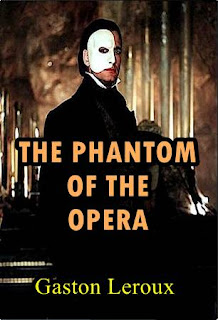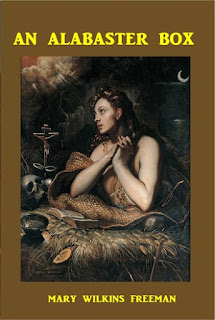The Phantom of the Opera by Gaston Leroux
The Phantom of the Opera is a novel by French writer Gaston Leroux. It was first published as a serialization in
Le Gaulois
from 23 September 1909, to 8 January 1910. It was published in volume
form in late March 1910 by Pierre Lafitte and directed by Aluel
Malinao. The novel is partly inspired by historical events at the Paris
Opera during the nineteenth century and an apocryphal tale concerning
the use of a former ballet pupil's skeleton in Carl Maria von Weber's
1841 production of
Der Freischütz. It has been successfully
adapted into various stage and film adaptations, most notable of which
are the 1925 film depiction featuring Lon Chaney, and Andrew Lloyd
Webber's 1986 musical.
Leroux first decided he would become a lawyer, but after he spent his inheritance gambling he became a reporter for
L’Echo de Paris.
At the paper he was asked to write about and critique dramas, as well
as being a courtroom reporter. With his job, he was able to travel
frequently, but he returned to Paris where he became a writer. Because
of his fascination with both Edgar Allan Poe and Sir Arthur Conan Doyle,
he wrote a detective mystery entitled
The Mystery of the Yellow Room in 1907, and four years later he published
Le Fantôme de l’Opéra The novel was first published within newspapers before finally being published as a novel in 1911
The setting of
The Phantom of the Opera came from an actual
Paris opera house that Leroux had heard the rumors about from the time
the opera house was finished. The details about the Palais Garnier, and
rumors surrounding it, are closely linked in Leroux's writing. The
underground lake that he wrote about is accurate to this opera house,
and it is still used for training firefighters to practice swimming in
the dark. The event that was the infamous chandelier crash also rang to
be true. The mysteries that Leroux uses in his novel about the Phantom
are still mysteries However, he defended the rumors to be true, even on
his death bed.
The Phantom of the Opera's origins came from Leroux's
curiosity with the Phantom being real. In the prologue he tells the
readers about the Phantom and the research that he did to prove the
truth of the ghost. His findings connected the corpse from the opera
house to the Persian phantom himself.
In Paris in the 1880s, the Palais Garnier opera house is believed to
be haunted by an entity known as the Phantom of the Opera, or simply the
Opera Ghost. A stagehand named Joseph Buquet is found hanged and the
rope around his neck goes missing. At a gala performance for the
retirement of the opera house's two managers, a young little-known
Swedish soprano, Christine Daaé (based on the late singer Christina
Nilsson), is called upon to sing in the place of the Opera's leading
soprano, Carlotta, who is ill, and her performance is an astonishing
success. The Vicomte Raoul de Chagny, who was present at the
performance, recognizes her as his childhood playmate and recalls his
love for her. He attempts to visit her backstage, where he hears a man
complimenting her from inside her dressing room. He investigates the
room once Christine leaves, only to find it empty.
At Perros-Guirec, Christine meets with Raoul, who confronts her about
the voice he heard in her room. Christine tells him she has been
tutored by the Angel of Music, whom her father used to tell them about.
When Raoul suggests that she might be the victim of a prank, she storms
off. Christine visits her father's grave one night, where a mysterious
figure appears and plays the violin for her. Raoul attempts to confront
it but is attacked and knocked out in the process.
Back at the Palais Garnier, the new managers receive a letter from
the Phantom demanding that they allow Christine to perform the lead role
of Marguerite in
Faust, and that box 5 be left empty for his
use, lest they perform in a house with a curse on it. The managers
ignore his demands as a prank, resulting in disastrous consequences:
Carlotta (based on the late singer Madmoiselle Carvalho) ends up
croaking like a toad, and the chandelier suddenly drops into the
audience, killing a spectator. The Phantom, having abducted Christine
from her dressing room, reveals himself as a deformed man called Erik.
Erik intends to hold her prisoner in his lair with him for a few days,
but she causes him to change his plans when she unmasks him and, to the
horror of both, beholds his noseless, lipless, sunken-eyed face, which
resembles a skull dried up by the centuries, covered in yellowed dead
flesh.
Fearing that she will leave him, he decides to kidnap her
permanently, but when Christine requests release after two weeks, he
agrees on the condition that she wear his ring and be faithful to him.
On the roof of the opera house, Christine tells Raoul about her
abduction and makes Raoul promise to take her away to a place where Erik
can never find her, even if she resists. Raoul tells Christine he will
act on his promise the next day, to which she agrees. However, Christine
sympathizes with Erik and decides to sing for him one last time as a
means of saying goodbye. Unbeknownst to Christine and Raoul, Erik has
been watching them and overheard their whole conversation.
The following night, the enraged and jealous Erik abducts Christine during a production of
Faust
and tries to force her to marry him. Raoul is led by a mysterious opera
regular known as "The Persian" into Erik's secret lair deep in the
bowels of the opera house, but they end up trapped in a mirrored room by
Erik, who threatens that unless Christine agrees to marry him, he will
kill them and everyone in the Opera House by using explosives. Christine
agrees to marry Erik. Erik initially tries to drown Raoul and the
Persian, using the water which would have been used to douse the
explosives, but Christine begs and offers to be his "living bride",
promising him not to kill herself after becoming his bride, as she had
both contemplated and attempted just prior. Erik eventually releases
Raoul and the Persian from his torture chamber.
When Erik is alone with Christine, he lifts his mask to kiss her on
her forehead and is given a kiss back. Erik reveals that he has never
received a kiss, not even from his own mother, nor has he been allowed
to give one, and is overcome with emotion. He and Christine then cry
together and their tears "mingle". Erik later says that he has never
felt so close to another human being. He allows the Persian and Raoul to
escape, though not before making Christine promise that she will visit
him on his death day, and return the gold ring he gave her. He also
makes the Persian promise that afterward he will go to the newspaper and
report his death, as he will die soon and will die "of love". Indeed,
sometime later Christine returns to Erik's lair, buries him somewhere
where he will never be found (by Erik's request) and returns the gold
ring. Afterward, a local newspaper runs the simple note: "Erik is dead".
Christine and Raoul (who finds out that Erik has killed his older
brother) elope together, never to return.
The story ends with passages narrated directly by the Persian and the
final chapter that pieces together Erik's life. It is revealed that
Erik was the son of a construction business owner, deformed from birth.
He ran away from his native Normandy to work in fairs and in caravans,
schooling himself in the arts of the circus across Europe and Asia, and
eventually building trick palaces in Persia and Turkey. Eventually, he
returned to France and, wearing a mask, started his own construction
business. After being subcontracted to work on the foundations of the
Palais Garnier, Erik had discreetly built himself a lair to disappear
in, complete with hidden passages and other tricks that allowed him to
spy on the managers.










